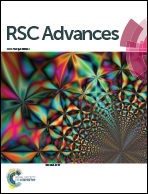Polylactide–hydroxyapatite nanocomposites with highly improved interfacial adhesion via mussel-inspired polydopamine surface modification
Abstract
The poor interfacial adhesion between organic and inorganic components remains the primary obstacle in obtaining composite scaffolds of high performance for bone tissue engineering. Mussel-inspired dopamine surface modification on inorganic components is a potential solution for this problem. Herein, hydroxyapatite (HA) nano-rods were freshly made by a co-precipitation method and subjected to polydopamine (PDA) coating. Then the modified HA nano-rods were mixed into biodegradable poly(L-lactide) (PLLA) to get PLLA/HA nanocomposites. The PDA modification was found to be mild and easy to handle, and was effective in improving the dispersibility of HA nano-rods in chloroform and especially in PLLA/chloroform solution. The resulting PLLA/HA composite films and porous scaffolds demonstrated significant enhancements in their mechanical properties at relatively high contents (30–60 wt%) of modified HA nano-rods in comparison with those composites containing unmodified HA nano-rods. This was thought to be mainly attributed to both the even distribution of modified HA nano-rods throughout the PLLA matrix and the strong interfacial adhesion between HA and PLLA components. The PLLA/HA composites displayed good biocompatibility with bone mesenchymal stem cells (BMSCs) and could enhance the osteogenic differentiation of BMSCs, indicating the PDA modification has no adverse effect on biological properties. These results confirmed the idea of using mussel-inspired dopamine surface modification as a feasible and efficient approach in developing organic–inorganic composite materials for bone regeneration studies.


 Please wait while we load your content...
Please wait while we load your content...